Today we are going into the Jewish Quarter of Berlin:). The Jewish Germans in Berlin were a very influential population and lived in different nuclei. Districts such as Schöneberg or Wedding had important Hebrew communities. The most important hotspots were the Scheunenviertel and Spandauer Vorstadt in Mitte. If one street can be considered the most important axis of the Jewish community in Berlin, it is Oranienburger Straße. There we will find the Jewish school and the new Synagogue.
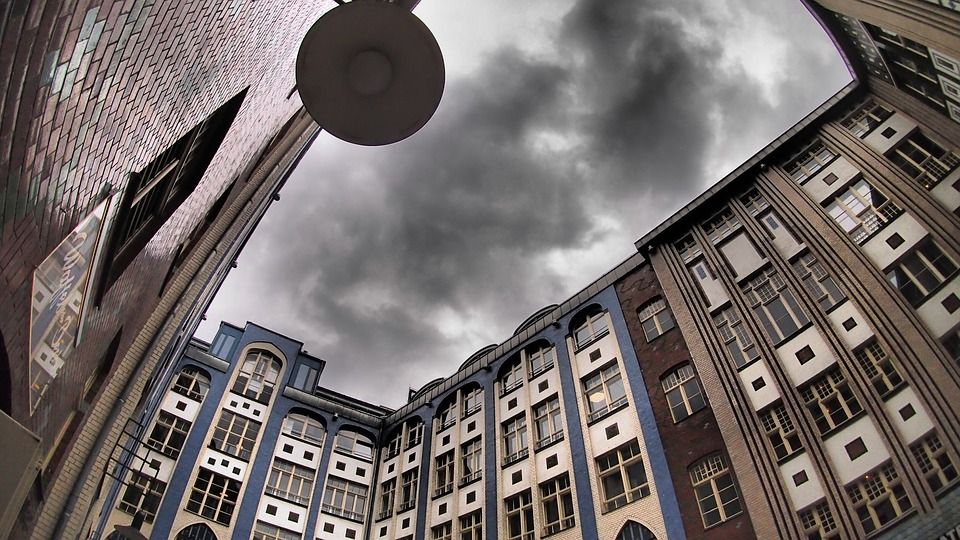
Photo: Wikipedia
If we continue walking we will find the beautiful Hackescher Markt station and just in front of it, the courtyards of the “.Hackesche Höfe“Hof is one of the city’s great attractions. Hof means courtyard in German, both locals and tourists count it as a must-see in Berlin. Located in the historic Scheunenviertel (“barn district”), it is the largest area of enclosed courtyards in Germany. On September 23, 1906 they were opened, the complex of buildings constitutes a mixture of offices, businesses, factories (especially on the second floor) and housing. Declared a historic monument in 1972, the courtyards were renovated in the 1990s and the concept was successfully revived.
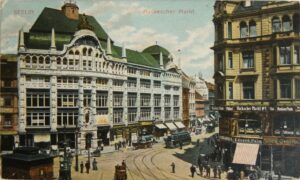
Source: Wikipedia
The people who lived in or visited Hackesche Höfe could be considered upper middle class. The project developers clearly reflected this in the design and architecture of the buildings. In the beginning, these courtyards were built to house a large number of businesses of all kinds: men’s clothing, leather, furniture, musical instruments, metal, etc… But also at that time they were used in a playful way, as dances were held for high society in their halls and was the epicenter of meetings of the neighbors in the area. After World War I, change began. Because many companies went bankrupt, they had to close down or move to other areas of Berlin.
[fusion_tagline_box backgroundcolor=”” shadow=”no” shadowopacity=”0.7″ border=”1″ bordercolor=”” highlightposition=”left” content_alignment=”left” link=”https://culturetouringberlin.com/tour-barrio-judio-berlin-alternativo/” button=”Reserva tu plaza” linktarget=”_self” modal=”” button_size=”” button_type=”” button_shape=”square” buttoncolor=”default” title=”Do you want to enjoy the best tour of Berlin’s Jewish quarter in English?” description=”El tour del barrio judío y Berlín alternativo te adentrará en la historia de la comunidad judía en Berlín, pero también en el día a día de una de las zonas con más movimiento de la capital alemana” margin_top=”” margin_bottom=”” hide_on_mobile=”small-visibility,medium-visibility,large-visibility” class=”” id=”” animation_type=”” animation_direction=”left” animation_speed=”0.3″ animation_offset=””][/fusion_tagline_box]
After the bombings of World War II, this courtyard complex was taken over by the state. For several years they made several reforms and improvements, but it was not until 1995, after the reunification of Germany, when a thorough restoration of the complex began. Today, the eight courtyards between Rosenthaler and Sophienstraße provide 27,000 m² of space for 40 industrial enterprises, cultural institutions and housing.

The“Hackeschen Höfe” is today one of the trendiest places in the center of Berlin, attracting hundreds of visitors every day. If you are tempted to make a purchase, you will see that they are not precisely economical, but quite the opposite.
The decoration of the facades, particularly those around the main courtyard(Hof I), is wonderful. Designed by the modernist artist and architect August Endell, the courtyard houses the cabaret “Chamäleon”, a cinema, as well as several bars and restaurants. Its style is a local variant of Art Nouveau, the Jugendstil.. As a curiosity, this very modern style was not well regarded by the emperor. German, but since these courtyards were not visible from the street, the architects avoided censorship . In the Höf II “Theaterhof”, the Hackesche Hof theater and a number of architects’ offices are located. In the rest of the courtyards there is a proliferation of small stores and galleries.
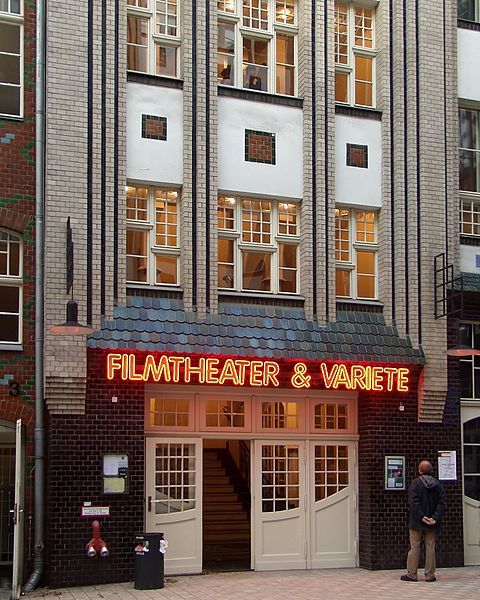
Source: Wikipedia
In the Höf V you will find the“Ampelman Shop“. In Hackeschen Höfen, the first store was opened in 2001 (the original). The Ampelman was one of the symbols of the former GDR, the famous traffic light man lit up to give way or avoid it to Berlin pedestrians. After reunification it disappeared, but years later it came back to life thanks to its creator and some advertisers. The store offers a multitude of items with its unique and fun image.
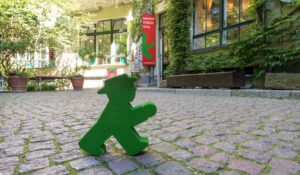
Source: www.ampelmann.de
Finally we find the famous Dead Chicken Alley(Dead Chicken Alley), do not be scared by the name of this culture collective 😀 . If you have not heard of this alley before or no one recommends you to visit it, you will probably not find it by chance, as it is a bit hidden. You can go through the access door several times and you won’t even notice it. The birth of this alley dates back to the time of the fall of the Berlin Wall. At that time, the desire for freedom and to break with the norms led to the birth of numerous cultural movements totally contrary to the established. Because it was strictly forbidden to paint on the city walls to vindicate through urban art and graffiti, a group of young people who called themselves “Los Pollos Muertos” bought this alley to be able to freely express their ideas and messages.

Photo: http://bit.ly/rimelycarmin
We walked through the door, right next to Cafe Cinema, a bar with a special charm for movie lovers. Once inside the alley we found an alternative area, with graffiti and murals. The Anne Frank museum and souvenir store, now converted into a social project. At the back of the building is one of the most picturesque staircases in Berlin, where you will find an art gallery and bookstore.

Source: Wikipedia
Finally we can have a drink at the“Eschloraque Rümschrümpp“, a bar that will not leave you indifferent when you see its style and decoration. On the other side a large tin monster stands guarding the Monsterkabinett. A place dedicated to the most sinister and curious mechanical creatures. On the corner, an old-fashioned movie theater completes the cultural offer.
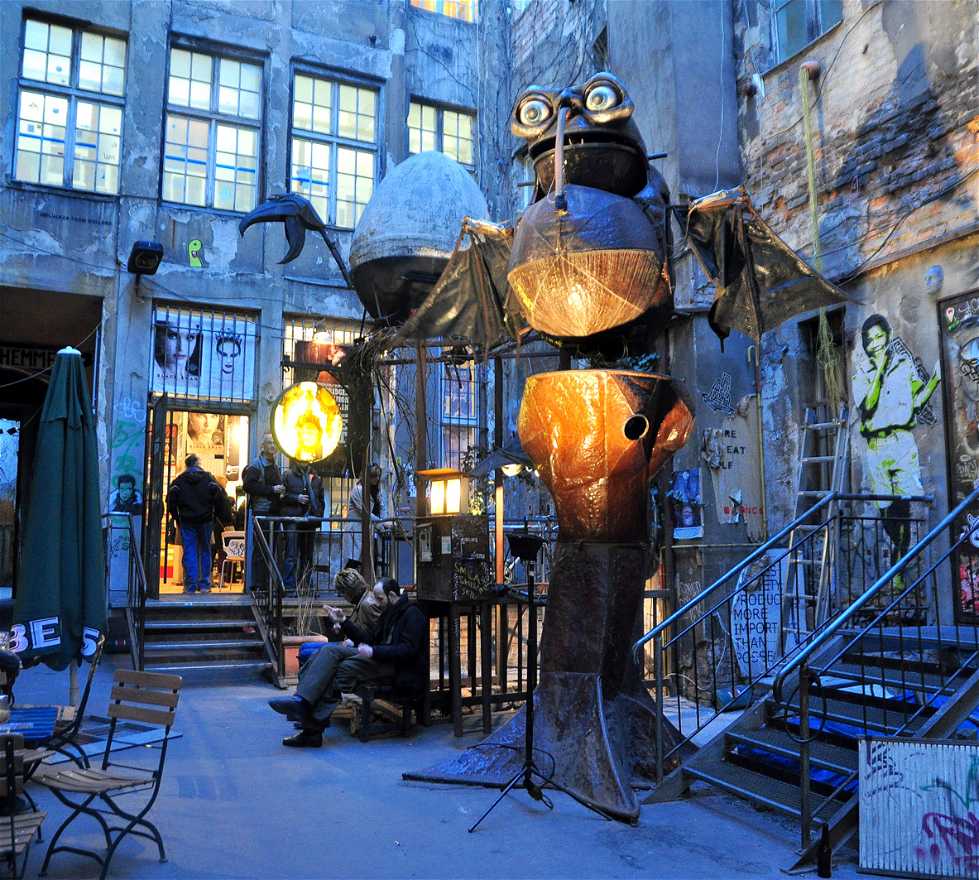
Dead Chicken Alley – Minube.com
A new shopping area with numerous bars, restaurants and clubs has been created around the courtyards, making this area an important part of Berlin’s nightlife.
To discover the Jewish courtyards, the memorials and the new synagogue, do not hesitate to book a place on our tour of the Jewish quarter 😀
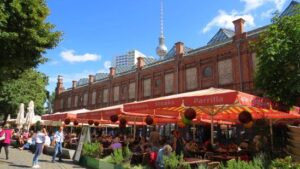
Source: Wikipedia


